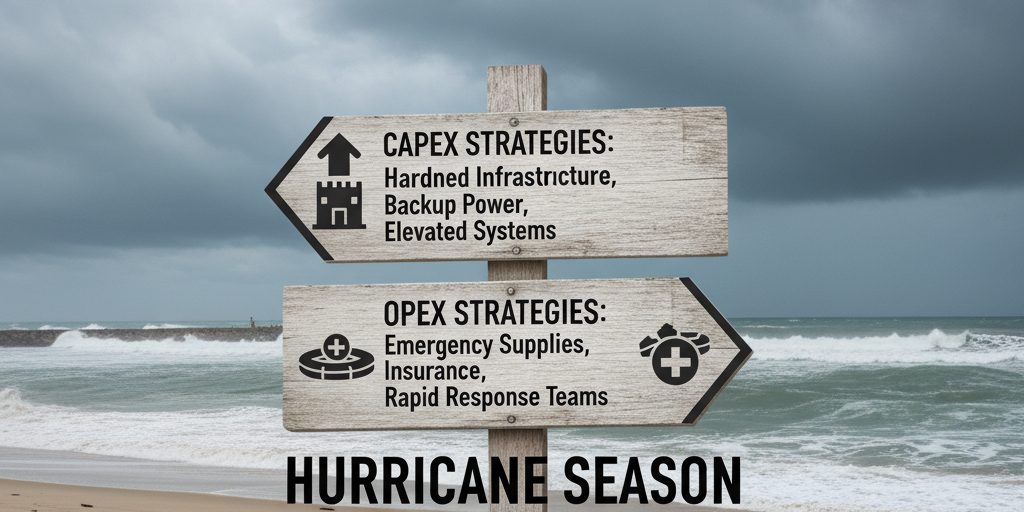Capex vs. Opex in High-Use, High-Risk Markets: Making Smart Financial Decisions During Hurricane Season
As natural disasters like hurricanes become both more frequent and severe, businesses operating in high-use regions—particularly those along coastlines—must make more calculated decisions about capital expenditures (Capex) and operational expenditures (Opex). Understanding how to allocate funds for long-term assets versus recurring costs is critical for efficient disaster preparedness, equipment maintenance, and insurance planning. In this article, we’ll explore how companies in high-risk markets can balance Capex and Opex strategies to strengthen operational resilience, reduce downtime, and enhance ROI. Read on as we break down how to approach expenditures before, during, and after hurricane season with financial precision.
Understanding Capex and Opex: The Basics and Why It Matters in Vulnerable Markets
Capex (capital expenditures) and Opex (operational expenditures) are two fundamental budgetary terms with vastly different implications. In regions prone to hurricanes and other severe weather events, understanding when to invest in long-term assets versus ongoing operational needs is crucial for sustainability.
– Capex: These are investments in physical assets like buildings, generators, HVAC systems, or fortified storage facilities. These costs are usually higher upfront and involve depreciation over time.
– Opex: These are recurring expenses like repair services, energy consumption, temporary labor, or emergency fuel supply.
Why does this differentiation matter in a high-risk region? Because each category has a different level of flexibility during a crisis and different tax implications.
For instance, investing in a storm-resilient building may require a significant upfront Capex, but it minimizes future operating expenses after a hurricane, such as replacing damaged infrastructure or relocating temporarily.
Hurricane Preparedness: Capex Investments That Pay Off
In hurricane-prone markets, certain Capex projects can provide immense value and risk mitigation over time. These long-term expenses are vital for keeping operations running smoothly before, during, and after extreme weather events.
Key Capex Priorities for Hurricane-Prone Areas:
– Fortified building upgrades (impact-resistant roofing, shutter systems)
– Commercial-grade backup power generators
– Elevated equipment to prevent flood damage
– Cloud-based IT infrastructure for seamless business continuity
– Stormwater drainage systems and water-resistant flooring
Business owners may be hesitant to commit to high Capex during years of low hurricane activity, but doing so beforehand significantly reduces operating interruptions and emergency repair costs later.
Opex Strategies for Maintenance, Monitoring, and Flexibility
While Capex provides a robust infrastructure foundation, Opex allows for operational agility—crucial during hurricane season where dynamic, real-time responses are vital.
Opex Expenditures to Prioritize in High-Use Markets:
– Preventive maintenance contracts for HVAC, roofing, and fleet vehicles
– Emergency fuel deliveries and generator servicing
– Remote facility Monitoring-as-a-Service (MaaS)
– Temporary security staff and service-based disaster response contracts
Having a well-managed Opex strategy means not just reacting to damage but actively minimizing damage through agile planning. For example, funding recurring inspections and pre-storm checkups ensures that Capex assets are maintained and functional when needed most.
Insurance Trends: Bridging Capex and Opex for Smarter Risk Management
Insurance costs are skyrocketing in hurricane-prone regions, especially across coastal states. Insurers are increasingly tying premium reductions to proactive investments in resilience—blending Capex and Opex decisions with long-term financial benefits.
Emerging Insurance Trends:
– Risk-based pricing models that reward proactive mitigation investments
– Telematics and IoT devices reducing premiums through real-time data sharing
– Expanded parametric insurance policies covering specific tranches of events (e.g., wind speed thresholds, rainfall amounts)
Companies can leverage these trends by:
– Documenting Capex improvements (e.g., fortified buildings)
– Showcasing Opex routines (e.g., updated roof inspections)
– Collaborating with insurers to use data from sensors or monitoring systems
By merging Capex investments and Opex routines into a clear risk reduction strategy, companies don’t just protect assets—they also position themselves for strategic savings.
Conclusion
In high-use markets frequently impacted by hurricanes, making the right financial decisions isn’t just about balancing the books—it’s about surviving and thriving amidst adversity. Understanding the distinct but interconnected roles of Capex and Opex allows organizations to invest wisely in durable infrastructure while remaining flexible and responsive through operational tactics.
Whether it’s through storm-resistant buildings, cloud-based continuity tools, or smart insurance policies, businesses that align their spending with regional threats can better serve their customers, protect their employees, and weather any storm. Now’s the time to evaluate your Capex and Opex strategies—before the hurricane sirens start to wail.
For more tips on disaster preparedness for businesses, check out our guides on emergency planning and How to Develop a Resilient Business Continuity Plan or visit the NOAA hurricane resources.
Don’t leave your finances—or your future—to stormy luck. Share this article with your operations team and start planning today.

